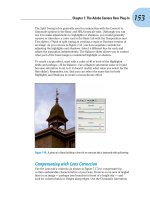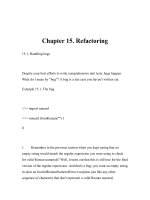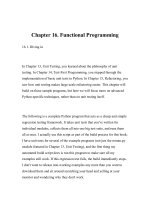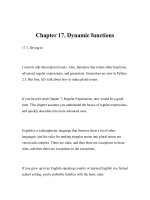Dive Into Python-Chapter 3. Native Datatypes
Bạn đang xem bản rút gọn của tài liệu. Xem và tải ngay bản đầy đủ của tài liệu tại đây (545.42 KB, 46 trang )
Chapter 3. Native Datatypes
You'll get back to your first Python program in just a minute. But first, a
short digression is in order, because you need to know about dictionaries,
tuples, and lists (oh my!). If you're a Perl hacker, you can probably skim the
bits about dictionaries and lists, but you should still pay attention to tuples.
3.1. Introducing Dictionaries
One of Python's built-in datatypes is the dictionary, which defines one-to-
one relationships between keys and values.
A dictionary in Python is like a hash in Perl. In Perl, variables that store
hashes always start with a % character. In Python, variables can be
named anything, and Python keeps track of the datatype internally.
A dictionary in Python is like an instance of the Hashtable class in
Java.
A dictionary in Python is like an instance of the
Scripting.Dictionary object in Visual Basic.
3.1.1. Defining Dictionaries
Example 3.1. Defining a Dictionary
>>> d = {"server":"mpilgrim", "database":"master"}
>>> d
{'server': 'mpilgrim', 'database': 'master'}
>>> d["server"]
'mpilgrim'
>>> d["database"]
'master'
>>> d["mpilgrim"]
Traceback (innermost last):
File "<interactive input>", line 1, in ?
KeyError: mpilgrim
First, you create a new dictionary with two elements and assign it to the
variable d. Each element is a key-value pair, and the whole set of elements
is enclosed in curly braces.
'server' is a key, and its associated value, referenced by
d["server"], is 'mpilgrim'.
'database' is a key, and its associated value, referenced by
d["database"], is 'master'.
You can get values by key, but you can't get keys by value. So
d["server"] is 'mpilgrim', but d["mpilgrim"] raises an
exception, because 'mpilgrim' is not a key.
3.1.2. Modifying Dictionaries
Example 3.2. Modifying a Dictionary
>>> d
{'server': 'mpilgrim', 'database': 'master'}
>>> d["database"] = "pubs"
>>> d
{'server': 'mpilgrim', 'database': 'pubs'}
>>> d["uid"] = "sa"
>>> d
{'server': 'mpilgrim', 'uid': 'sa', 'database':
'pubs'}
You can not have duplicate keys in a dictionary. Assigning a value to an
existing key will wipe out the old value.
You can add new key-value pairs at any time. This syntax is identical to
modifying existing values. (Yes, this will annoy you someday when you
think you are adding new values but are actually just modifying the same
value over and over because your key isn't changing the way you think it
is.)
Note that the new element (key 'uid', value 'sa') appears to be in the
middle. In fact, it was just a coincidence that the elements appeared to be in
order in the first example; it is just as much a coincidence that they appear to
be out of order now.
Dictionaries have no concept of order among elements. It is incorrect to
say that the elements are “out of order”; they are simply unordered. This
is an important distinction that will annoy you when you want to access
the elements of a dictionary in a specific, repeatable order (like
alphabetical order by key). There are ways of doing this, but they're not
built into the dictionary.
When working with dictionaries, you need to be aware that dictionary keys
are case-sensitive.
Example 3.3. Dictionary Keys Are Case-Sensitive
>>> d = {}
>>> d["key"] = "value"
>>> d["key"] = "other value"
>>> d
{'key': 'other value'}
>>> d["Key"] = "third value"
>>> d
{'Key': 'third value', 'key': 'other value'}
Assigning a value to an existing dictionary key simply replaces the old
value with a new one.
This is not assigning a value to an existing dictionary key, because strings
in Python are case-sensitive, so 'key' is not the same as 'Key'. This
creates a new key/value pair in the dictionary; it may look similar to you,
but as far as Python is concerned, it's completely different.
Example 3.4. Mixing Datatypes in a Dictionary
>>> d
{'server': 'mpilgrim', 'uid': 'sa', 'database':
'pubs'}
>>> d["retrycount"] = 3
>>> d
{'server': 'mpilgrim', 'uid': 'sa', 'database':
'master', 'retrycount': 3}
>>> d[42] = "douglas"
>>> d
{'server': 'mpilgrim', 'uid': 'sa', 'database':
'master',
42: 'douglas', 'retrycount': 3}
Dictionaries aren't just for strings. Dictionary values can be any datatype,
including strings, integers, objects, or even other dictionaries. And within
a single dictionary, the values don't all need to be the same type; you can
mix and match as needed.
Dictionary keys are more restricted, but they can be strings, integers, and a
few other types. You can also mix and match key datatypes within a
dictionary.
3.1.3. Deleting Items From Dictionaries
Example 3.5. Deleting Items from a Dictionary
>>> d
{'server': 'mpilgrim', 'uid': 'sa', 'database':
'master',
42: 'douglas', 'retrycount': 3}
>>> del d[42]
>>> d
{'server': 'mpilgrim', 'uid': 'sa', 'database':
'master', 'retrycount': 3}
>>> d.clear()
>>> d
{}
del lets you delete individual items from a dictionary by key.
clear deletes all items from a dictionary. Note that the set of empty
curly braces signifies a dictionary without any items.
Further Reading on Dictionaries
How to Think Like a Computer Scientist teaches about dictionaries
and shows how to use dictionaries to model sparse matrices.
Python Knowledge Base has a lot of example code using dictionaries.
Python Cookbook discusses how to sort the values of a dictionary by
key.
Python Library Reference summarizes all the dictionary methods.
3.2. Introducing Lists
Lists are Python's workhorse datatype. If your only experience with lists is
arrays in Visual Basic or (God forbid) the datastore in Powerbuilder, brace
yourself for Python lists.
A list in Python is like an array in Perl. In Perl, variables that store arrays
always start with the @ character; in Python, variables can be named
anything, and Python keeps track of the datatype internally.
A list in Python is much more than an array in Java (although it can be
used as one if that's really all you want out of life). A better analogy
would be to the ArrayList class, which can hold arbitrary objects and
can expand dynamically as new items are added.
3.2.1. Defining Lists
Example 3.6. Defining a List
>>> li = ["a", "b", "mpilgrim", "z", "example"]
>>> li
['a', 'b', 'mpilgrim', 'z', 'example']
>>> li[0]
'a'
>>> li[4]
'example'
First, you define a list of five elements. Note that they retain their original
order. This is not an accident. A list is an ordered set of elements enclosed
in square brackets.
A list can be used like a zero-based array. The first element of any non-
empty list is always li[0].
The last element of this five-element list is li[4], because lists are
always zero-based.
Example 3.7. Negative List Indices
>>> li
['a', 'b', 'mpilgrim', 'z', 'example']
>>> li[-1]
'example'
>>> li[-3]
'mpilgrim'
A negative index accesses elements from the end of the list counting
backwards. The last element of any non-empty list is always li[-1].
If the negative index is confusing to you, think of it this way: li[-n]
== li[len(li) - n]. So in this list, li[-3] == li[5 - 3]
== li[2].
Example 3.8. Slicing a List
>>> li
['a', 'b', 'mpilgrim', 'z', 'example']
>>> li[1:3]
['b', 'mpilgrim']
>>> li[1:-1]
['b', 'mpilgrim', 'z']
>>> li[0:3]
['a', 'b', 'mpilgrim']
You can get a subset of a list, called a “slice”, by specifying two indices.
The return value is a new list containing all the elements of the list, in
order, starting with the first slice index (in this case li[1]), up to but not
including the second slice index (in this case li[3]).
Slicing works if one or both of the slice indices is negative. If it helps, you
can think of it this way: reading the list from left to right, the first slice
index specifies the first element you want, and the second slice index
specifies the first element you don't want. The return value is everything in
between.
Lists are zero-based, so li[0:3] returns the first three elements of the
list, starting at li[0], up to but not including li[3].
Example 3.9. Slicing Shorthand
>>> li
['a', 'b', 'mpilgrim', 'z', 'example']
>>> li[:3]
['a', 'b', 'mpilgrim']
>>> li[3:]
['z', 'example']
>>> li[:]
['a', 'b', 'mpilgrim', 'z', 'example']
If the left slice index is 0, you can leave it out, and 0 is implied. So
li[:3] is the same as li[0:3] from Example 3.8, “Slicing a List”.
Similarly, if the right slice index is the length of the list, you can leave it
out. So li[3:] is the same as li[3:5], because this list has five
elements.
Note the symmetry here. In this five-element list, li[:3] returns the first
3 elements, and li[3:] returns the last two elements. In fact, li[:n]
will always return the first n elements, and li[n:] will return the rest,
regardless of the length of the list.
If both slice indices are left out, all elements of the list are included. But
this is not the same as the original li list; it is a new list that happens to
have all the same elements. li[:] is shorthand for making a complete
copy of a list.
3.2.2. Adding Elements to Lists
Example 3.10. Adding Elements to a List
>>> li
['a', 'b', 'mpilgrim', 'z', 'example']
>>> li.append("new")
>>> li
['a', 'b', 'mpilgrim', 'z', 'example', 'new']
>>> li.insert(2, "new")
>>> li
['a', 'b', 'new', 'mpilgrim', 'z', 'example',
'new']
>>> li.extend(["two", "elements"])
>>> li
['a', 'b', 'new', 'mpilgrim', 'z', 'example',
'new', 'two', 'elements']
append adds a single element to the end of the list.
insert inserts a single element into a list. The numeric argument is the
index of the first element that gets bumped out of position. Note that list
elements do not need to be unique; there are now two separate elements
with the value 'new', li[2] and li[6].
extend concatenates lists. Note that you do not call extend with
multiple arguments; you call it with one argument, a list. In this case, that
list has two elements.
Example 3.11. The Difference between extend and append
>>> li = ['a', 'b', 'c']
>>> li.extend(['d', 'e', 'f'])
>>> li
['a', 'b', 'c', 'd', 'e', 'f']
>>> len(li)
6
>>> li[-1]
'f'
>>> li = ['a', 'b', 'c']
>>> li.append(['d', 'e', 'f'])
>>> li
['a', 'b', 'c', ['d', 'e', 'f']]
>>> len(li)
4
>>> li[-1]
['d', 'e', 'f']
Lists have two methods, extend and append, that look like they do the
same thing, but are in fact completely different. extend takes a single
argument, which is always a list, and adds each of the elements of that list
to the original list.
Here you started with a list of three elements ('a', 'b', and 'c'), and
you extended the list with a list of another three elements ('d', 'e', and
'f'), so you now have a list of six elements.
On the other hand, append takes one argument, which can be any data
type, and simply adds it to the end of the list. Here, you're calling the
append method with a single argument, which is a list of three elements.
Now the original list, which started as a list of three elements, contains
four elements. Why four? Because the last element that you just appended
is itself a list. Lists can contain any type of data, including other lists. That
may be what you want, or maybe not. Don't use append if you mean
extend.
3.2.3. Searching Lists
Example 3.12. Searching a List
>>> li
['a', 'b', 'new', 'mpilgrim', 'z', 'example',
'new', 'two', 'elements']
>>> li.index("example")
5
>>> li.index("new")
2
>>> li.index("c")
Traceback (innermost last):
File "<interactive input>", line 1, in ?
ValueError: list.index(x): x not in list
>>> "c" in li
False
index finds the first occurrence of a value in the list and returns the
index.
index finds the first occurrence of a value in the list. In this case, 'new'
occurs twice in the list, in li[2] and li[6], but index will return only
the first index, 2.
If the value is not found in the list, Python raises an exception. This is
notably different from most languages, which will return some invalid
index. While this may seem annoying, it is a good thing, because it means
your program will crash at the source of the problem, rather than later on
when you try to use the invalid index.
To test whether a value is in the list, use in, which returns True if the
value is found or False if it is not.
Before version 2.2.1, Python had no separate boolean datatype. To
compensate for this, Python accepted almost anything in a boolean
context (like an if statement), according to the following rules:
0 is false; all other numbers are true.
An empty string ("") is false, all other strings are true.
An empty list ([]) is false; all other lists are true.
An empty tuple (()) is false; all other tuples are true.
An empty dictionary ({}) is false; all other dictionaries are true.
These rules still apply in Python 2.2.1 and beyond, but now you can also
use an actual boolean, which has a value of True or False. Note the









